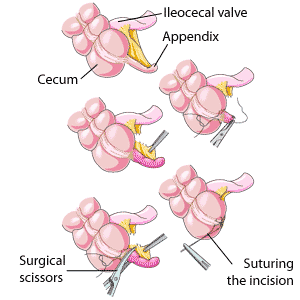Description of the procedure
An appendectomy is surgery to remove the appendix. It is the standard treatment for appendicitis, an inflammation and infection in the appendix. The appendix is a small, finger-shaped pouch attached to the colon. It can become infected if stool becomes trapped in it or as a result of another infection. In an appendectomy, a surgeon removes the appendix from the colon and then closes the hole left in the colon.
Anyone can develop appendicitis; however, it is more common in people between the ages of 10 and 30, with most cases occurring in children between 8 and 16 years old. It is also slightly more common in males. Appendicitis may be diagnosed in your doctor's office or at the hospital. An appendectomy is always done in a hospital under anesthetic.
When should this procedure be performed?
An appendectomy is done if you are diagnosed with appendicitis. Because you only have one appendix and it cannot grow back after being removed, you can only have an appendectomy once.
Why is this procedure performed?
An appendectomy is performed to remove a swollen and infected appendix. Your appendix can become swollen and irritated when its opening becomes blocked, causing bacteria to grow on the appendix wall. The appendix then becomes infected and may fill with pus, resulting in abdominal pain that can become very severe over a matter of hours. If the appendix is not removed, it could burst and spread the infection into the abdomen and increase the risk of serious complications.
Are there any risks and precautions?
Certain risks are common to all surgery and anesthesia. These risks depend on many factors including the type of surgery and your own medical condition. The possible, but very rare, side effects include: side effects of the anesthetic, breathing problems, infection, bleeding, scarring, and death.
The most common risk associated with an appendectomy is an infection around the stitches following surgery. The infection may be mild, causing redness and tenderness, or severe, requiring antibiotics and further surgery. There is also the risk of infection in the area where the appendix was, requiring further treatment. Bleeding and damage to other organs are other risks associated with surgery.
If you experience these side effects or complications, contact your doctor immediately.
These side effects should go away with time, however, if they persist or become bothersome, talk to your doctor.
An appendectomy will leave a scar on the abdomen. Laparoscopic surgery may leave less scarring because the openings are smaller.
If you are concerned about any symptoms following this procedure, speak to your doctor. Take the time to be sure you understand all the risks of complications and side effects as well as any precautions you or your doctor can take to avoid them. Be sure your doctor understands all your concerns.
What happens during the procedure?
In an open appendectomy, your surgeon will make an incision 2 to 4 inches long in the lower right part of your abdomen, where the appendix is located. After locating the appendix, your surgeon will first make sure there are no other problems visible that could be causing the pain. Your surgeon will then remove the appendix from the colon, seal the opening in the colon, and close the opening in your abdomen with stitches. If the surgeon sees any infection, he or she will first drain the pus using rubber tubes. In some cases, the infection must be drained and given time to heal before the appendix can be removed. The surgeon then does a second surgery to remove the appendix.
In a laparoscopic appendectomy, the surgeon usually makes several small incisions in the abdomen. A small viewing device called a laparoscope (a thin fibre-optic tube with a video camera attached) is inserted into one of the openings to allow the surgeon to see the procedure on a screen. The appendix is then removed using small tools that are inserted into the other openings. If the appendix cannot be safely removed with this technique, your surgeon may need to change to an open appendectomy.
Both traditional and laparoscopic appendectomies are done with anesthetic. Both methods take about 1 to 2 hours to complete.
During the surgery, if the surgeon finds that the appendix is not swollen or infected, the surgeon will inspect the surrounding organs. The surgeon will likely remove the appendix anyway to prevent any future complications.
How should I prepare for this procedure?
Before having this procedure, discuss the advantages, disadvantages, long-term risks, and consequences associated with the procedure with your doctor. Be sure you fully understand what will happen and are comfortable with your doctor’s answers to your questions.
Before the appendectomy, your doctor will order several tests. These include a physical exam, blood and urine tests, and X-rays or other imaging techniques to diagnose appendicitis and rule out any other causes for the abdominal pain. You will also be given intravenous (IV) antibiotics and pain medication before the surgery. An anesthesiologist will administer the anesthesia and monitor you during the surgery. You will also undergo all the usual preparations for a surgical operation.
Do not eat for 8 hours before the procedure. If your doctor has recommended different times, follow the timing recommended by your doctor.
Tell your doctor or prescriber about all prescription, over-the-counter (non-prescription), and herbal medications that you are taking. Also tell them about any medication allergies and medical conditions that you may have. Arrange for someone to drive you home from the hospital.
Ask your doctor or pharmacist whether you need to stop taking any of your medications before the procedure.
What can I expect after the procedure?
Following an appendectomy, you will spend time in a surgical recovery room, sometimes followed by a day or two in the hospital. After this procedure, you will likely feel these normal side effects: discomfort, pain, and tenderness around the stitches. Your doctor may prescribe a painkiller for this pain.
Before you go home, the doctor or nurse will go over what you need to do at home to complete your recovery.
The first post-surgery meal is usually a clear liquid diet (e.g., juice, broth, Jell-O®), and this can be changed to a regular diet as soon as you can tolerate it.
To reduce the risk of infection, you will be given follow-up instructions and shown how to care for the stitches following your release from the hospital. If your appendix was infected or had burst, you may require a slightly longer hospital stay and you may need to take antibiotics.
Results
The abdominal pain caused by the appendicitis should ease immediately following surgery. However, you will likely experience some pain or tenderness around the stitches as a result of the surgery itself.
Recovery from appendicitis and the surgery is usually complete, and if there are no complications, you will likely be able to return to your normal activities within 1 to 3 weeks. This recovery time can be shorter if you had laparoscopic surgery.
All material copyright MediResource Inc. 1996 – 2024. Terms and conditions of use. The contents herein are for informational purposes only. Always seek the advice of your physician or other qualified health provider with any questions you may have regarding a medical condition. Source: www.medbroadcast.com/procedure/getprocedure/Appendectomy




